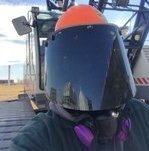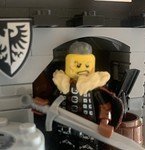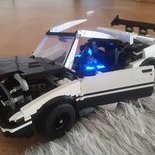Search the Community
Showing results for tags 'wip'.
Found 313 results
-
Hey all, I've been lurking in the forums for a month or so after i saw a lego big boy some time ago by morningstrummer, Ive long wanted to get back into a model railroad hobby but never could very much due to living conditions or expense and now i find my self at an odd crossroads of sorts. The skinny is I've since made a WIP MOC of the Southern Pacific AC-9 based on morningstrummer's big boy in Stud.IO ( I have a thing for articulated locomotives ) but find myself after having just nearly finished the whole loco and its tender thinking of going with an O Scale set instead as both layouts, add-ons, rolling stock, etc. etc. will end up costing me the same but both lack things i enjoy of both hobbies. One is building with lego's, stepping back and seeing the creation ( move and make sound even! ) then two being the wider availability and setup of O Scale and to stretch even HO for that matter. At this point i just really don't know what direction i should take the dive, as i wont be able to do both by a monetary standpoint, and y'all seem to have the wealth of information. Oh and here is my wip, Spoilered for convenience.
-
I wanted to continue with my current Dune obsession but there really isn't all that much inside the Dune universe which lends itself to be transformed into Lego. But I figured that a sandworm + rider would be a nice challenge. I have gone into Stud.io and tried to come up with something. While I do like the current look, I'm not sure if I continue down that path. The damn thing is just too big. It sits on three 32x32 base plates. We're already at more than 3600 pieces and the rear end is still missing, plus I only have a rudimentary support structure for the sand dunes. So I expect a final design to end up quite a bit north of 4000 pieces which is just unreasonable. Still, it was fun so far, so I might at least finish the design in Stud.io. But I doubt that I'll take it any further than that.
-
UPDATE - March 2023 - INSTRUCTIONS are still available via PayPal donation - just let me know or write me a mail to boonatix@gmail.com :) Prevously: Working on the instructions is close to the finish... WIP - Instructions by Brickmasta on Flickr UPDATE - FINISHED on 22nd of April The Batwing - Front by Brickmasta on Flickr See the Album with details and more: https://www.flickr.c...th/13973416094/ ----------------------------------- I would like to present my current WIP to you all and love to get some feedback on it As soon as I saw the first Trailer for "The Lego Movie" I was in shock... a childhood dream coming true. With so many awesome creations in it. And one was standing out the first time I saw it: "The Batwing". I immediately knew that I needed to build this asap. Even though I just came back out of the dark ages by end of last year and was very fresh to all the building processes, parts and stuff... I thought It can't be that hard with having the model right in front of me on the screen. But it wouldn't be as easy as I thought... I researched all the internet for more pictures / trailers, fortunately there was more released with special scenes and stuff for this Batwing. I did frame by frame analysis and took a whole lot of screenshots, scratching my head how and where to start. I had the best material of one of the turbines, so I just got to work on one of those! But then I was kind of lost... not enough details, not enough shots of the Batwing. And then somebody on Flickr linked me a video to the Lego Movie Videogame. Woah! There was actually a building process you could unlock in there for it. I had to get the game, started gaming until I was able to unlock this plan and rebuild it over and over to see how they did it. And got to the point where I finally started with one of the wings! The Batwing - WIP #003 by Brickmasta at Flickr And the first challenge occured and I knew it would not be that simple / as easy as I hoped. The wing consists of 4 sections. And each section basically just featured 1 connector, making the whole wing completely unstable, bending and nearly breaking apart. That did not look good. So I got to understand that I won't be able to do a 1:1 true copy of it. The physics in the movie and the videogame are just easier / different because there is no real physics So I got to work again and tried and tried and thought and planned... and found a solution! First step was to double and exchange the connections for each section: The Batwing - WIP #004 by Brickmasta at Flickr But that was not quite enough and after some more thinking I had another idea, so I took the shot and gave the second wing a try with new elements in it and a stabilizer under the wing, connecting the sections and holding them together... and it worked out! "The Batwing" is going to be huge...! That is my progress so far. I am now starting to work on the cockpit and will try out the connections from wing to cockpit asap because I have a feeling they also won't hold up that good... each wing weighs around 260gr wich is around 0,6 pounds. That is quite a lot to be held together by slim Lego connectors. Lets see how this will work out then Let me know what you think! Appreciate every comment and input
- 142 replies
-
- the lego movie
- batwing
-
(and 5 more)
Tagged with:
-
Here is a project that I have been maturing for 4 years and which finally takes shape from this year, inspired by a french comic strip from Arthur De Pins.. Throughout this topic, you can follow the progress of the project and the WIP. This first post will bring together only the completed games and winks to the universe. For those who do not know Zombillenium, visit Dupuis, the editor of Arthur de Pins (link in french): https://www.dupuis.com/seriebd/zombillenium/3204 Park map: 1. Gretchen and his Mini Cooper S : 2. Carousel with skulls : Great inspiration from those found in the comic strip park, but which I found a bit repetitive, especially this one. 3. "At work !" : Zombillenium - "At work !" by Stephle59, sur Flickr 4. "Cheeeeers..." Zombillenium - "Cheeers... Creepy family photo !" by Stephle59, sur Flickr The family photo, with from left to right: - Sirius Jefferson the skeleton - Aton Noudjemet the mummy - A demon worker like Aurelien Zahner - Francis Von Bloodt the vampire and director of the park - Blaise Canilhac the werewolf and director of human resources - Gretchen Webb the witch 5. Candy shop : Zombillénium - Main Street, Candy shop by Stephle59, sur Flickr To be continued...
- 84 replies
-
- wip
- zombillenium
-
(and 6 more)
Tagged with:
-

(WIP Thread) Manta's MOCs
Mantarri posted a topic in LEGO Technic, Mindstorms, Model Team and Scale Modeling
Thought I'd create a thread to just post WIPs of my MOCs, or neat mechanisms. Finished: Generic Muscle Car -
While I'm waiting for the parts to do my mod of the official Dune Ornithopter Set, I decided to play around a bit more and try to do the smaller thopter which Paul and Jessica used in the Dune Part 1 to escape the Sardaukar. This is of course still a very early stage. I started with the cockpit and then tried to design a downsized version of the flapping and folding mechanisms which I've basically taken from the official set. I will not include the the cool landing gear though. For one, it would take up too much space and secondly, the landing gear on this thopter works differently than on the one which was the template for the official Lego set. Maybe I can think of something really smart, but in the end, I'll probably just use ball joints, so that the landing gear will have to be put into place manually. Which means that from here on out, the main challenge will be to shape the exterior. One thing I have to admit to is that I have cheated with the colours. Unfortunately, these trans-yellow pieces don't exist. In the end, I'll have the choice between trans-clear and trans-brown. I think trans-brown will look nicer. Here's an interior shot of the cockpit with trans-clear windows.
-
So I’ve always flip-flopped between sci-fi and fantasy themes. After spending several years firmly building spaceships I’ve decided to give a castle and medieval village build a go. My style is always with play in mind and some leeway towards historical accuracy. This is very much a work in progress. My aim is to make something sort of modular, not just to rearrange but to make it easier to move to allow my kids to play with it. I have another experimental build I tried, a half timbered house in the black and white style that I want to try and incorporate. Thoughts and comments very welcome! So you can see the overall plan, a quadrangular castle with a central keep, able to be closed up and opened. All off the corner towers and wall sections are connected with pins. Gate section. I intend to add a drawbridge style gate to the front. With chains if possible. Apart from some small variations in the colours, all four corners are the same. The two side walls again are quite similar. The SNOT bricks I plan to use for some kind of climbing foliage. I also plan on making small sub builds to connect to the inside of the walls; a forge and smithy, a pig pen, a small half timbered lodge, a storage pile etc. Something to give it some life. The longer of the two rear wall halves has the bridge to the keep. And the keep itself. I plan on another floor, which may have some half timbered extensions, and a roof top access. Interior-wise, the bottom floor has the dungeon and cellar. The middle will have a small hall and for the top I think a bed chamber makes sense. I want to add details to this section like torches on the walls, trophies, other decorations. I’ll add more pictures of the half timbered house I’ve started, as well as other sun builds and progress pictures as I go, as well as the figs I think will inhabit here. I welcome feedback and suggestions for other details and sub builds. Thank you for taking the time to go through this.
-
I have to say, the Dune Ornithopter is probably my favourite new set in many years. But of course it is a bit rough and the bright colours are as always annoying. So I sat down in Studio and tried to make the Thopter look a bit smoother. Regarding the following picture, my modded version does not have the spring installed, that's why you can see the large gap next to the top right wing. In the finished product, it'll be there, of course. Side by side, you can also see that my mod is about 6 studs longer. Might look a bit funky with the wings folded in, but the overall proportions do look more like the movie thopter. If anything, it probably should be even longer, but then the wingspan would be more out of whack, so I figured that this was a good compromise. I'll have to see how it works in real life though. All in all still not perfect of course. It's just very hard to get a smooth surface. Plus, I wanted to keep all the functions and there was only so much one can do regarding the large gaps in the central section due to the folding mechanism. The tail construction is a bit wild, but it should be almost as sturdy as the original tail. Next step is to get the parts and try to build the thing. There might be some fine tuning needed which will only become obvious when dealing with real life bricks.
-

[WIP] Rate my axle setup
damian_kane_iv posted a topic in LEGO Technic, Mindstorms, Model Team and Scale Modeling
I'm trying to design a realistic 5-link axle for an upcoming crawler idea. I wanted to make a genuine 5-link with as much travel as possible and a differential locker. I think I have the geometry 99% there. I also plan to add pneumatic shocks to complement/dampen the coil springs. Lego's new springs were appealing and compact, but the 9.5L springs have much more travel needed for high axle articulation. Let me know what you think/how it can improve: Here you can see the coils, the shock and most of the suspension links. This is a close-up with the pneumatic cylinder removed. The axle is designed for ~1:9-1:11 sized mocs and can be fitted with either a portal axle mounts (pictured here), or traditional ungeared mounts. Here you can see the lower control arms, the panhard rod, and diff locker. Here's a picture of the underside. I based this design off of Madoca's Dacoma axle. This was originally designed to accommodate a power ball joint for a more trophy truck-like suspension, but I have converted it into a 5-link axle design and scaled it up for 1:10 models. Finally, the underside of the chassis contains the upper control arms, mounting for panhard (bottom), and the driveshaft As you can see, this was formerly a powerjoint setup and can be converted back if desired. -
Hello, long time lurker but never contributed anything. I been considering ideas to let my 12v trains also use the 9v/RC tracks and one of the problems was to make the 12v curved rails fit I guess other people have tried this to, but I realize by removing in total 4 stud I would get a snug fit and also a more convenient way to build track layouts. I also modified some straight tracks to be able to connect them with 12v rails switch points etc... I made as short video showing the process using cheap RC tracks and the next step would be using copper tape (and I need a extra set of 9v contact points) for the 9v system, not sure if I want to tape the 12v switch track but I guess I can test it out on a "broken" track. I thought that traction could be a problem but it seems to handle it well (test drive at the end of the video), there is some spinning when starting the train with "high" voltage but at soon as it moves it's coping quite well.
-
General MOC-Discussion Ahoy! Ever felt like there's not enough general talk going on here about what matters most in these waters - MOCs? Ever got frustrated over a certain issue with a WIP that you could need help with? Ever thought about posting a WIP but didn't think it would deserve its own thread? Ever wanted to announce a huge, mind boggling, or simply your next project and ask your fellow EB members what they think about that idea? Or have you ever just felt the urge to tease everyone with a blurred picture of your creation or some facts about it before releasing it for good? Well, hesitate no further, this is the place for you! Use this thread as a vessel for all the otherwise unmentioned MOC related talk, use it to discuss sail sizes and capstan designs, ask for ideas, help others with their MOC issues and tease your fellow mateys... with pics of your creations, of course
- 281 replies
-
- Pirate Long Standing Topics
- teaser
- (and 4 more)
-

Jorgeopesi´s WIPs and sometimes even MOCs
jorgeopesi posted a topic in LEGO Technic, Mindstorms, Model Team and Scale Modeling
I decided to do this thread because I am tired to open new ones again and again, so enough speaking about me lets go for the almost MOCs. It seems that we are on dumpers time because I am working on this massive small truck. It will be very simple, only 2 axles steering and bed tipping but I had some problems... the angle and weigh of the bed due the lack of room when the steering work, bed itself also was a problem with technic parts and the scheme color will be a imposible to solve problem at least for the real MOC. I think I do not have to say which the truck is.- 17 replies
-
Hello guys, this is a kinda last minute octraintober submission: a beurer "rangiertraktor" first off all, a little bit of backstory to the prototype: these where small shunting vehicles built by the Maschinen- und Armaturenfabrik vorm. H. Breuer & Co and where later licenced to be produced by many companys. they where used to carry around single or small groups of wagons with weights of up to 80-500 tons. the first iteration the type I had a completely open construction and a whopping 10 HP (no this is not a typo) here is a sketching of one: the type II had 28 HP. sadly i havent found a sketching or picture of this one the type III had a real cockpit for the operator to stand on and operate the machine. it looked like this and had 40HP: the type IV and V looked basically identical except that the type V had 80 HP without further ado here are the pics: there isnt much of a wip story here as the construction of the model only took me like 20 minutes. the renders took the same time as building the model the second one shows how the wagons attached to the thing. they where raised by this pin that sticks up and the weight of the wagons rested on the tractor thus giving it huge ammounts of traction to pull up to 500 tons edot: changed the position of the windows. made two renders the one where it shows how the wagons attach where made quick and dirty with pov-ray. here is the second render: hope you like this last minute submission! here is the link to the studio file for anyone to build and have fun with! https://www.dropbox.com/s/7scoqnohh0qszog/rangiertraktor v2.io?dl=0# edit: now i have an update for you guys. what is better than a small lego train model? a motorized lego train model! this uses a modified cheap "tower pro sg90" servo as its motor. the servo has been modified in such a way that it basically works like a normal brushed dc motor. i have removed the servo control board and the stops preventing the servo from rotating more than 180 degree. there are several tutorials available online on how to do this. the second modification the servo got was removing the mounting points of it at the top to make it smaller. the servo fits into the model like this: the drivetrain consists of a small white lego rubber band which drives one of the trainwheels directly (no need for gearing down as the servo has internal gearing already which is sufficient). the second pulley is one of the servos attachments just with the arms cutoff and made flush with the rest of the center hub). here is the whole thing complete with the drivers cab: i changed some of the details due to my parts library and space constraints with the taller base but overall it is the same model just different colors (it is a very old unit so a bit of rust is also present ). the drivers cab just fits loosley onto the model as the servo doesnt really fit into the lego geometry height wise and i didnt want to make the model any taller so thats how it is. it fits quite snugly though so no problem there. and finally there is a video so you guys can see it running: https://www.flickr.com/photos/145736297@N05/52187870612/in/dateposted-public/ hope you like this upgrade and as always the models files can be found in the link in my signature for anyone wishing to recreate this little model.
- 36 replies
-
- wip
- octraintober
-
(and 1 more)
Tagged with:
-

[WIP] MCI D4500CT Commuter Coach
JLiu15 posted a topic in LEGO Technic, Mindstorms, Model Team and Scale Modeling
Last year, I built a MOC of the NJ Transit New Flyer XD60 Articulated Bus. That model was a huge success, so back in August I started working on another bus model: the NJ Transit 2016-2022 MCI D4500CT Commuter Coach. I anticipate this model having a lot more functionality than my XD60 model. There will be 6 motorized functions total, 4 of which are controlled via a 4-output distribution gearbox. The model will use Control+ electronics, with a single hub powering 4 motors (1 C+ XL for drive and 3 C+ L for steering, gearbox functions and gearbox switching). The 4 motorized functions controlled via the gearbox will be opening/closing the passenger door, extending/retracting the wheelchair lift, raising/lowering the wheelchair lift, and opening/closing the wheelchair door. The model will also feature suspension on all axles. I believe the real MCI D4500CT have independent front and tag axles and a solid driven axle (not 100% sure), but a such a setup might be too complicated so I went with a live axle suspension on all axles. I also plan to include a model of the Cummins X12 engine with mini pistons, which can be removed from the chassis as the pistons won't be visible when the engine model is inside the bus. Only the 2020-2022 (plus a handful of 2019) models have the Cummins X12 engine (previous years had the Cummins ISX12 engine), so my model will be of a 2020 or newer unit, most likely 2021 as the 2021 order was by far the largest. I started designing the model in Stud.io shortly after BrickFair VA back in August, focusing primarily on the chassis. The biggest challenge was making sure the wheelchair lift can fully extend/retract from the chassis and not interfere with any other mechanisms. The wheelchair lift's transverse range of motion takes up almost the entire width of the bus, so it was difficult making sure I can squeeze all the functionality in there without compromising on looks. Making sure I had the space to fit everything was also a challenge, as the distribution gearbox and Control+ hub both take up a lot of space. I have a preliminary version of the chassis modeled in Stud.io, and have begun building the physical model. The chassis is a very dense build, with plenty of mechanisms running through it. I also have the "stainless steel" side panels (all metallic silver - definitely won't be cheap) and seats in place in the Stud.io model. The Stud.io model is already over 4000 pieces, so I think this model will easily surpass the part count of my XD60 model. Just like my XD60 model, because I am modeling it in Stud.io, I plan to publish instructions for this MOC when it's finished. I've included some photos of the physical model as of right now (I mostly just have the gearbox section done), and some screenshots of the Stud.io model showing its progress since August. Photos: -

[WIP] Lifted Truck with 3 steering modes
JLiu15 posted a topic in LEGO Technic, Mindstorms, Model Team and Scale Modeling
With my Ripsaw Tank MOC essentially done by now (just waiting for some final pieces to arrive) and my PAB order for my New Flyer XD60 articulated bus model still yet to arrive (with more pieces coming for that), I've decided to start another MOC in the meantime. This will be my second model combining Control+ and Robot Inventor after my Heavy Duty Skid-steer Loader. It will have two identical axles, each with a steering motor (medium angular motor) to control steering, and thanks to their absolute positioning feature I don't think I'll have to calibrate it every time, like on e.g. the 42099 set. I was originally planning to use Control+ L motors for the steering, and have this be a Control+ MOC, but found the medium angular motor to fit better with the absolute positioning being another plus. I plan on creating a control profile in the Mindstorms app with different sliders for normal, crab, and 4-wheel steering modes. The drivetrain consists of heavy-duty differentials and planetary hubs, so this eliminates the need for significant gearing down inside the chassis. For propulsion, I plan to use 2 Control+ XL motors, with a fake engine driven by a separate motor. This way, the fake engine can run at all times and there will be less friction in the drivetrain. I anticipate building the chassis to be pretty straightforward, as the entire chassis is essentially a mirror image with two identical axles. As for the bodywork, I'm leaning towards a red car-like body. If so, I will probably name this MOC "Red Beryl C", where "C" is for Crawler. It would be the third model in my Red Beryl series, after my Red Beryl GT of 2018 and Red Beryl X of 2019. Let me know what you think, and any suggestions you may have. Photos: The front axle, with planetary hubs, long shock absorbers, and a medium angular motor for steering: The front axle, with the wheels attached. Note that this is the underside, with the heavy-duty differential visible: -

[MOC]Generic brushless Trophy Truck
Ryokeen posted a topic in LEGO Technic, Mindstorms, Model Team and Scale Modeling
Well where to start, after i got back into building technic sets, the urge to create something of my own took over and i started to look around places where ppl discuss mocs, building techs and so on. That's how i got to eurobricks and the topics about rc and brushless motors in the lego world took my interest, cause moving things are cool. The eagle truck and in general the various mocs daniel-99 made gave me the motivation to create my own trophy truck and see how well bricks and rc components match. It's currently still wip as it's lacking a proper bodywork and might change once i can test it properly(to rainy atm). I'm not the best at presenting so feel free to ask. Quick overview: 4-Link live axle in the back Double wishbone in the front 3250kv brushless motor on 2s Lipo Geekservo for steering All carbon axle driveshaft fully with ball bearings Metal gears and metal u-joints Strong chassis for serious offroad driving Underbelly protection So far i'm using wheelhubs from zene with ball bearings and their closed metal differential. The whole driveshaft uses carbon axles, metal u-joints, metal gears and ball bearings. I kinda tried to mimick tropy truck suspensions, so it got a 4 link live axle in the back and a double wishbone suspension in the front. Havn't figured out how i could add roll protection on the back axles as my first attempt didn't seem to help. The use of triangle geometry gives the chassis enough strenght to take a fall from around 50cm without any damage. Another way i used to reinforce the chassis is the use of longer m3 screws and mathcing nuts as they fit perfectly through 3L pins and stabilize them aswell as preventing the connection to get apart. Good thing is they don't rly damage the parts, as they work similiar to 3L bars inserted into pins, just better. As i said i wanted to test how well rc components match with bricks so the first thing was using a brushless motor. The size is almost the same as a 540 brushed one so it was easy to mount using some m3 screews and 2x 32184 parts, for now. An mod 1 pinion gear with 12 tooths provides the connection to the drivetrain. As the motor got quite a punch and high rpms i decided to only use metal gears on carbon axles seated in ball bearings. Additionally i lubed them with some lithium grease. Currently the total gear reduction is 1:10 including the diff. That gives me around 2500rpms on the wheels with a fully charged lipo and plenty of torque. First i used 9L springs but in the first freefall test one of them broke, so i thought why not use rc dampers ? And 1:10 scale ones fit quite well. Their upper holes fit the pin diameter and the lower balljoint connection got a 3mm hole in them. Some screwing later they worked like a charm. Might even switch over to only use such shock absorbers as they can be tuned better. So far that's all, if one got questions, just ask, if one got suggestions, pls let me hear them. -

[Updated 12/02/23] Sunbelt Rentals JLG 1250AJP Boom Lift WIP
Captain Contractor posted a topic in LEGO Town
Update - December 02, 2023 Finished the model and ordered the pieces through BrickLink. I had to make some compromises, mainly with removing the idea of having the axles be extendable, and some issues with the safety bars of the manbasket. However, I am working with a company that makes decals for the real machine so that my MOC will have a full sticker set. Here's a few more pictures, showing how the side panels open, as well as the SNOT (potentially illegal building techniques) that I used for the glazier kit on the underside of the basket. JLG 1250AJP MOC Digital by Captain Contractor, on Flickr JLG Basket Underside MOC by Captain Contractor, on Flickr JLG Basket Underside by Captain Contractor, on Flickr Anyways, thanks for looking once more! I can't wait to share the completed thing with y'all! ------------------------------------------------------------------------------------------------------------------------------------------------------------------------------------------------------------------------------------------------------------------------------------------------ Figured I'd share some progress of a build I've been working off and on in Studio 2.0. This is a scaled-down version of a 125 ft/38m boom lift built by JLG. I'm building it in the colors of Sunbelt Rentals, which is a nationwide North American machinery rental company. So far, it has both side compartment access panels functioning, with plans to include the extendable axles just like the real machine. I hope to have this model complete and built by the end of December. Lego JLG 1250AJP WIP by Captain Contractor, on Flickr And here's an image of the real machine for reference. Sunbelt JLG IRL Picture by Captain Contractor, on Flickr Thanks for looking!-
- wip
- studio 2.0
-
(and 3 more)
Tagged with:
-
This was my first concept for a series of 4-person SxS vehicles but it came out to 8 wide, which seems excessive. So I am going to try a few techniques that were suggested by my lug for narrowing it down. SxS Offroad vehicle by Benjamin Sarles, on Flickr
-

Shipwrights Guild Hall (WIPs, feedback, and advice)
Bregir posted a topic in Brethren of the Brick Seas
Greetings, shipwrights. Whether a novice, an apprentice, a master, or a veteran shipwright, following the process of others, sharing your own, and giving and receiving feedback can help everyone improve. What's the point? This is just a place for all of us liberally to post WIP's for feedbacks, tips, suggestions, and questions, without otherwise littering the BoBS forum with WIP's. You can post just one step in the process, or several over a period. It's all up to you. So I am working on a vessel/ship - what do I do? Post one or more pictures, questions, ship-plans, descriptions, etc. here, and hopefully someone will step in with some wonderful advice. At least, I expect to do so. I know NOTHING about ships - can I comment, and how do I do? Everyone with something constructive to say can comment. No need to be a scholar in historic vessels, medieval carpentry or sail making. Sometimes it might just be aesthetics, a crazy idea, a suggestion for a technique, use of a specific brick, or whatever you can think of. Just keep it nice and constructive. In return, builders posting here will pwomise not to take offense! I'd suggest tagging the builder you are commenting on. But I am not an expert - the arrogant elite will laugh at my puny attempts at shipbuilding! First of all, the arrogant elite was not invited. In fact, they have been given specific instructions to go back to their fancy little elitist coffee houses to talk about how brilliant they are. Secondly, regarding puny attempts, take a look at my first attempt at a ship just two and a half years ago... Well, you really don't have to look. Move along... Nothing to see here... The rather obvious point being, we all start somewhere, and no matter where you start, or how steep your learning curve is. The only requirement is that you want to share your process, learn from others, share your ideas, and/or improve. Soooo, is this something official? What will I gain from participating? EGS bonuses? HAH! This is merely me gone rogue - and I may hang from my toes for it! No official bonuses here. However, I'd like to see a bit more focus on the process and techniques of building here, and I think ships is an interesting place to start. This is, however, quite likely to be replaced, superseded, or added to by something official at some point in the future. Who manages this and keeps the record? Manages? Keeps records? Bwahahaha - forget it! Just post your WIP's and comments. Don't overthink it! ________________________________________________________________________ Kick off! Oooohkay, here we go: I have been working on a 4th rate, circa 50 guns on two decks. I present to you: The HMS Endeavour. Started here: Went here: And have ended here: She is supposed to be the first in a series of 4th rates designed for colonial waters. A 4th rate is a small ship of the line between 46 and 60 guns, just above frigate size. This one is (IC) specifically designed to serve as flagship for colonial squadrons, sailing in consort with frigates and sloops. Looking forward to hearing your comments! And to see your WIP's! -
LEGO Sci-Fi universal WIP feedback thread. Do you have a Work In Progress (WIP) build that isn't working ? Do you have a problem that you can't just figure out how to get the look that you want? Did you create something but not sure how to use it? Do you want to help out a fellow builders? Then this this thread is for you! During the great EB oppsies of 2012, one of the discussions had off forums was the creation for a universal WIP thread that everyone could post what they were working on, this helps clean up the forums a bit, as well as provide a proper and centralized location where people could get some help on what they were working on. So EVERYONE post away! Throw in things you're working on and our esteemed Sci-Fi members will chime in and help you the best we can. I'll start! This was an attempt at a micro-ship / drone.... WIP micro ship drone thingy by Si-MOCs, on Flickr I've had this thing sitting on my desk for awhile, it had promise, but I just couldn't really get it to a point where I liked it. The idea was almost a bio-ship that felt a bit like armadillo armouring, with some asymmetrical striping. But it's kinda just a blob... Anyone got any ideas? or just scrap it? ...
- 204 replies
-
- wip thread
- advice please
-
(and 3 more)
Tagged with:
-

[WIP] Red Beryl T (Trophy Truck)
JLiu15 posted a topic in LEGO Technic, Mindstorms, Model Team and Scale Modeling
Another RC motor MOC I am working on. This time the RC motors will be configured differently - they are located in the chassis, placed in a cross configuration so that their inner outputs are lined up. There is a 2-speed remote controlled gearbox at the heart of the chassis along with the RC motors and there will be full long-travel suspension. The front suspension module is already complete, and it will be attached at an angle for positive caster. There will still be some gearing down in the rear suspended portion (e.g. with portal hubs) to ensure the model has sufficient torque. As the name might suggest, this is the third model in my Red Beryl series (not sure why I chose that name, honestly ). It'll be a typical trophy truck with either a fully red body or red with black detailing. I've always wanted to use my older-generation Technic panels from the 8436 set, sorta combining two generations of Lego Technic. Like a typical trophy truck, there will be one or two spare wheels in the back. Like my previous MOC, it will all be controlled by BuWizz. Photo: Update: I initially planned this MOC in late 2020 but decided to cancel it after challenges arose. I revived the project with a smaller scale, simpler drivetrain, and newer Technic panels. -
After a LONG absence.. New project! :) Aiming for done by May
-
Hi everyone! I want to create an off-road vehicle with these functionalities: - Speed around 13-16km/h - Positive caster angle - Good steering radius - Covering bottom of the car - Vehicle must be as versatile as possible (on-road, off-road, climbing capability) - that is why it is called Frontliner - No melting/damaged axles(or other parts) or at least minimal wear - this is with usage of brushless motor A2212 1000kv - Weight around 1,2 kg - Big wheels 100-110 mm (provide additional ground clearance) - Two-speed gearbox (optional functionality, may be implemented in the future) - Total gear reduction set to approximately 12:1 (including differentials reductions, etc. This still provides good speed of the model with usage of brushless motor) - Pendular suspension (optional functionality, currently implemented and it's very useful) What I will be using (non-lego): - RC setup (DumboRC X6FG - provides gyro stabilization) - Geek-servo motors (those works simply as servo-motor, but with 6 channels of the receiver I might use additional geek-servo motor as switch for gearbox) - A2212 1000kv brushless motor (I was previously using different BL motor, but this one is 14-pole, which means it has shorten rotating angle per-pole and is more precise in working with the throttle than 2838 3200/4500kv BL motor) - Metal universal joints (those are simply more robust than Lego ones) - Lucas oil white lithium grease (used to lubricate gears and axle holes) - 35A ESC - 3s li-po battery This is the first time I am seriously using Bricklink Studio to create a MOC. I had few attempts before, but this time I really pushed myself to at least design front and rear axle in it. Front axle: I used Geek-servo motor to steer the model (the front red weird stack of liftarms is actually it, dimensions 3x3x5). It also features planetary hubs, reinforced steering joints and planetary hubs. Rear axle (heavily insipired on @gyenesvi 42129 C model): We can see here the new differential (knock of part for now. I am soon gonna buy 42157 set to replace it with original Lego one). The yellow UV joint symbolizes metal version of it. Middle section: The yellow stack of gears symbolizes A2212 brushless motor. Between two 5x7 frames I hold battery and on top of that all RC components. This provides placement of all RC components in relatively small place. A2212 motor can rotate around 11100 RPMs at max throttle, then it is gear down 20:28 (differential gear). The differential distributes the power between the front and rear axles, which in my opinion creates less axle load than with just regular 28-tooth double-bevel gears. After joining above components into one setup I received the first prototype: I bought third-party wheels just out of curiosity and I have found that they weight slightly less than Lego ones, with pretty much same radius - 103mm. The body is just something I come up with in one day, I do not worry about that part for now as it is just prototype. At first I wanted to use 23801 steering hubs, but after few test runs with above model they simply couldn't stand the pressure. Other than that, the small steering joints were popping out from wheel hubs during steering on bumpy road. So that left me with only two solutions. Either I will use old portal hubs or new planetary ones. The first ones are more suited for big trucks, at least for me. So the choice was to go with the second option. (We need to wait for the Lego Audi set 42160, hope it will have good steering hubs, that support CV ball joints and are without planetary reduction) With that setup I was afraid that main shaft will have too much speed (around 7900 rpm at max throttle) and axles will start to melt. I was surprised when I took apart the model after hard run, because parts were in perfect shape! Those positive results are I believe because of light weight and short driveshaft. I am far from over with this model, that is why I submitted this topic. There is still room for improvement in those areas (at least :D): - Steering radius is simply poor. I thought that If I will put servo on the front and steering rack as close to the center of front axle it will solve the problem, but appareantly no. If you guys have ideas how to solve that or know any good front axle solutions I will be more than happy. - I need to cover bottom of the car. Shouldn't be problematic, but needs to be pointed out. - Body will be totally new. With 42157 set going soon into my arms and 42136, 42149 already in my hands I will be going with one main color and I believe you know which one I am aiming at. :) - Two-speed gearbox, but It will probably change overhaul look of middle section - Extending rear section. This is tricky one, current solution do not put much stress on axles, but with longer rear driveshaft it would give more "Trophy truck" vibes into it (and I love that :D). Other than stress on axles, this modification will actually shorten steering radius even more, so I am really thinking about implementing it. That's it. If you survived this wall of text I am more than happy. Here is GALLERY for you. Do not hesitate to write under this topic as I am open to suggestions and questions about this MOC.
-

[WIP] 2015 New Flyer XD40 MTA Bus
JLiu15 posted a topic in LEGO Technic, Mindstorms, Model Team and Scale Modeling
Following the success of my New Flyer XD60 model, I decided to take the existing design and remake it into an XD40 in Metropolitan Transportation Authority (MTA) livery. I am doing the 2015 model since newer ones have the new blue livery which will be much harder to build in LEGO due to the availability of dark blue pieces. The design uses my previous XD60 model as a base, but this model is more than simply my XD60 model cut down by 20 scaled feet. The chassis is redesigned from scratch, with the front and rear axles at a half-stud offset to allow for smaller and thus more realistically sized wheel arches. The body panels are also attached to the chassis using white Technic bricks with axle hole connected to a white Technic piece with axle, allowing for a seamless finish with no visible pins. A number of details have been polished up since my XD60 model, but perhaps the biggest difference is that the livery won't be sticker-dependent on this model. The simple blue stripe livery means I can easily model it with LEGO pieces, and stickers will only be used for the bus numbers/lettering. I've only modeled it in Stud.io so far, but I largely know what to expect since my XD60 model so the actually building process should be pretty straightforward once the model is finished in Stud.io. Photos: -

[WIP] Mack Granite Boom Truck
JLiu15 posted a topic in LEGO Technic, Mindstorms, Model Team and Scale Modeling
With the gearbox-controlled mechanisms on my MCI D4500CT model proving to be impractical, I did not want to just abandon the gearbox design. Because of this, I decided to incorporate it into a different vehicle. I decided that a boom truck like the following would be god for a four-output distribution gearbox: I have not seen many boom trucks in this style done in LEGO Technic. I've seen plenty of mobile cranes, knuckle boom cranes, etc, but I figured this would make for a unique build, especially as I see plenty of these here in the US. The turntable for the crane is also mounted higher up (at the same height as the roof of the cab), so that'll provide more space for mechanisms. As of right now, the chassis consists of essentially everything to the rear of the wheelchair ramp module on my MCI D4500CT model. A difference is that both rear axles are driven, as opposed to one driven axle and one tag axle. The gearbox outputs will control the outriggers, boom rotation, boom elevation, and either boom extension or winch. There can only be two functions routed through a turntable in order to allow for unlimited rotation, so one of the boom functions will have to be manual. Because the suspension design is identical to that of my MCI D4500CT model, this model will also serve as a test bed for the drivetrain and suspension on my MCI D4500CT model. If everything works well here, I can be pretty confident using this suspension design. Let me know if you have any suggestions for me! Photos:









